|
George Wade and His Cornhuskers, Part 1
© Arthur E. Zimmerman, Betty Minaker Pratt and Rob Gilmore
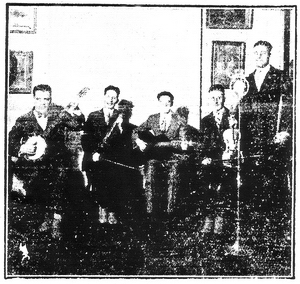
|
|
The first published photograph of George Wade and his Cornhuskers (G, Jan. 16, 1929, p. 23), with three violins, banjo and guitar. Note that George, at the CFRB microphone at right, is carrying a violin bow and a violin. The fiddler to Wade’s right looks like
Bill Cormier. The location, with pictures on the walls, might be the CFRB studio in the Ryan Art Galleries, Massey Mansion.
|
|
|
We roll up the carpet and pile up the chairs,
Then pick out our partners, get set for the squares;
When the music commences and George starts to call,
We dance to the tune of "Old Lannigan’s Ball".
The Music’s a tonic to hearts that are sair;
Your broadcast’s the best that comes over the air. (Weir, p. 146)
We don’t often think about how much our little world in Canada has changed over the last fifty or sixty years, what with Globalization, urbanization, big oil, big pollution and the pervasiveness
of the new electronic social media. What has actually been lost is our sense of and knowledge of our own social and cultural history.
Square dance and hoe-down music, the entertainment of their grandparents, was big on records and on early radio all over the continent from the 1920s, broadcasting beginning with
"Glenn's Cornhuskers" on the National Barn Dance on clear-channel WLS Chicago in 1924. A year later the WSM Barn Dance (later the Grand Ole Opry) started out of Nashville and Toronto
DXers could also tune in down-home music from WGY Schenectady, WOS Jefferson City, Missouri and WJR Pontiac, Michigan.
For several years, George Wade with his rollicking rhythms was one of the most popular novelty musical aggregations on Canadian radio (TDS, Sept. 26, 1930, p. 27). Canada was far more
rurally based in those long-gone days and all across the country in the early 1930s, people with radios would roll up the carpets, invite in the neighbours and everybody would dance to Wade's
country and "old-timey" music. Old folks may remember the country-dance broadcasts on the Dominion Network of the CBC by Don Messer and his Islanders or of Cotter's Saturday Night out
of CJCB, Sydney, but Wade and his Cornhuskers, with his three or four violins, was the model for those bands. Furthermore, Wade is known for discovering and employing legendary Quebecois
folk-fiddler Jean Carignan (1916-1988).
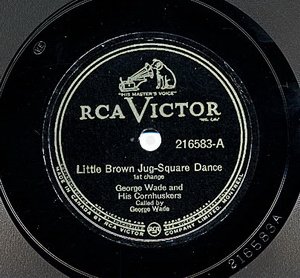
|
|
According to Jack Litchfield’s chronology of the Canadian
Victor 216000 series, Wade began his series of recordings for RCA
Victor in Montreal between 1931 and 1935. “Little Brown Jug”
(216583-A) was recorded in 1935.
|
|
|
In this article, we are trying to lay the foundation for a thorough documentation of George Wade's life and career.
Wade's Cornhusker forces varied a great deal in size. At first appearance, around March, 1928, at CFRB, he asked for pay for himself and three men. A 1929 photo from The Globe, showing
George at the microphone with violin and bow, has two other violinists, a guitarist and a banjo player. An undated photo from CFRB, likely around 1930, shows Wade at the microphone with ten
musicians, many of them in rural finery: three fiddles, bass, banjo, drums, piano, guitar and possibly two singers. Another undated CFRB photo has Wade plus two fiddles, banjo, drums, piano,
cello and trumpet. By 1933 he had three fiddles, bass, Spanish guitar, banjo, Jew's harp, piano, trumpet and drums. The composition of his group actually became quite similar to that of the
big jazz bands, with a couple of players doubling on saxophone and trumpet for modern dances, and he always had at least two excellent fiddlers.
Wade and his Cornhuskers recorded twenty-six 10-inch electrical sides for RCA Victor in Montreal, within the sequence 216569 to 216584. According to Jack Litchfield's work, the first eight sides
were waxed July to December, 1931, the next six possibly in 1932, six more in 1933 and the last six in 1935 (Litchfield). So Wade's was the first Canadian country band to make commercial
recordings, a year or more before the celebrated "Wilf" Carter.
Who Was George W. Wade?
George William Wade was born as George W. Waite in Summerside, P.E.I., on December 23, 1897. His paternal grandfather Benjamin Wate, himself born at sea in 1807, was married to P.E.
Islander Sarah McDonald and one of their children, George, was born in Tignish, P.E.I., January 14, 1853. This George, as George Wait, married Elizabeth Gaudet of Tignish in 1880 at St. Jude
Roman Catholic Church in Tignish. Their children were Joseph W. (born 1882), Mary Jane (1884), Margaret Ann (1888), son Sylvain (1891) and George W. (born 1897). In the 1901 Census of
Canada, George, Senior, was now Waite. Eldest son Joseph, labourer, married Emilie Martin in 1904 and he will re-surface later in Shediac, N.B.

|
|
Portrait of George Wade, "Popular 'Husker".
(G, Jan. 29, 1930, p. 19)
|
|
|
Our George, as George Wait, Junior, age 8, turned up in the Manitoba Census taken July 17, 1906, living with his mother in Souris, Manitoba. Elizabeth Wait was calling herself a widow and working
as a servant for farmer Thomas Mair (1906 Census of Manitoba, etc). No record of a Wait divorce was findable in Maritime archives (Owen) but Elizabeth married Anglican immigrant Charles Peter
Pennells in Souris on May 23, 1907. We have no indication of how George got along with his step-father, but with his job as section man on the CPR, Charles could have afforded fiddle lessons for
the boy. Later, George recalled that he had been calling "do-see-do's" since he was 12 years old, circa 1909, so early lessons was a good possibility (MCC, May 30, 1946, p. 7). George Waite,
Senior, former fisherman and junk dealer, remarried in Moncton on December 19, 1911, to a widowed Baptist. He had some sort of serious attack in 1912 and died after a second attack of
"central apoplexy" on November 29,1914, in the Provincial Hospital (formerly the Lunatic Asylum) in Saint John (RD St. John).
We found no further record of young George until August 10, 1915 when as George Waide, a former member of the 12th Manitoba Dragoons, he enlisted in the Canadian Overseas Expeditionary
Force (COEF), No. 425450, at Sewell Camp (LAC), giving his trade as printer and Mrs. Pennells as next-of-kin. At 5 foot 9 inches, of medium complexion and blue eyes, he was rejected as medically
unfit; possibly tending to flat feet. The 1916 Manitoba Census listed him as a printer and press officer and then he surfaced as George Waide, printer, living in Sarnia in early 1917 and, along with his
friend Alvan C. Mitchell, was refused admission to the U.S.A. at Port Huron (Ancestry.ca). Later, living in Walkerville, he re-applied for the COEF at Windsor on May 25, 1917, giving his name
as George W. Waide, employment as clerk ("mechanic" crossed out), was accepted, given No. 2265566 and assigned to the Signal Training Depot, Ottawa, Canadian Engineers, to be a sapper.
His military record (LAC), after arriving in England aboard the S.S. Grampian on December 31, 1917, shows persistent problems with his eyesight, including nystagmus, and with an ongoing throat
irritation that he claimed was pre-existing. He never got across the Channel to the fighting in France and there is no indication in the COEF record that he was a musician. He was struck off service
and embarked for Halifax aboard HMT Caronia on March 29, 1919, was demobbed in Kingston on April 8 and headed back to Souris.
Post-WW I
One or more George Wade/Waite turned up in the Might's City of Toronto Directories from 1919 to 1921, listed as a barber, a hardware store clerk and stenographer for Hydro, but we are not sure
that any was our man. He was listed in the 6th Census of Canada, taken in June 1921 as George Wade, bookkeeper, living in Souris with his mother and step-father. In a 1933 interview, he said that
he had worked in the Northern Ontario bush for four years, and that could be where he mastered calling country dances and perhaps went back to his fiddling: "That's where people really enjoy old-time
music. I have seen as many as 4,000 people doing the square dance at one time" (TDS, Apr. 8, 1933, p. 22).
Perhaps after his four years in the bush, 1921-24, our George W. Wade turned up in Toronto in 1924, working at The Levis (waste paper) and living at 47 Sullivan. From 1925 through 1929, Might's
listed him as a "chauffeur", possibly a driver- mechanic, for the Post Office and living at a different address each year.
Wade and His Cornhuskers on the Radio

|
|
One of Wade’s early sponsors was “Vapex, the Inhalant That Breathes Your Cold Away”, a U.S.-based product distributed in Canada by the Kennedy Manufacturing Company of Montreal.
(G, Jan. 16, 1929, p. 23)
|
|
|
One day, wearing his postman's cap, George Wade walked into the new Rogers Batteryless radio station CFRB in Tommy Ryan's Art Gallery (the former Massey Mansion) on Jarvis Street, Toronto,
and told co-managers Ernie Bushnell and Charles Shearer that he had a very popular barn-dance group that could play on the radio for $7.50 each for his three men and $9 for himself. They whittled
him down to $20 for an hour show (Weir, p. 83) but Ernie Bushnell later said that the Cornhuskers used up $45 of the station's $50 weekly budget for non-sustaining programs (Stursberg, p. 21).
Since Bushnell was hired as co-manager of CFRB along with Charles Shearer in June 1927 and both were fired in March, 1928, Wade's hiring must have occurred before March 1928. The band was
first listed on CFRB from 10:00 - 11:00 p.m. for Saturday, June 2, 1928 (TDS, p. 8) as the "Old-Time Dance Program" and then every Saturday night until July 7 when it was announced as
"Wade's Old-time Dance" (G, p. 7). It wasn't until October 26 in CFRB's "Studio News" (G, p. 22) that the name "George Wade and his Corn Huskers" appeared in print for the first time.
The first published photo of George Wade and his Cornhuskers (G, Jan. 16, 1929, p. 23), shows George at the microphone, carrying a violin and bow. As speculated, above, perhaps his stepfather in
Souris got him violin lessons or perhaps he picked up the rudiments in the bush, 1921-24. Paul Russell's aunt recalled that Wade was the caller and did not play the fiddle, but this photo, Steve Fruitman's
suggestion that he was a harmony-fiddler (personal communication) and an entry in 33.45.78 - The CIUT 89.5 FM All Vinyl Radio Show calling him "caller & fiddler" could indicate otherwise. Wade may have put down his
violin after the Cormiers, and later Jean Carignan, joined the group and outclassed him.
By January 16, 1929, their sponsor was the Kennedy Manufacturing Company, Canadian distributors of "Vapex the Inhalant That Breathes Your Cold Away" (G, Jan 16, 1929, p. 23) and they were
"positively guaranteed to set the most tired feet tapping from ten to eleven (p.m.)" (G, Feb. 13, 1929, p. 21). In late February, the Cornhuskers appeared at a gala night for old-time dancers at the
King Edward Hotel (G, March 1, 1929, p. 15) and in March they did the first run-out gig that we found, to Barrie, Ontario, on March 14 (BE, Mar. 28, 1929, p. 15).
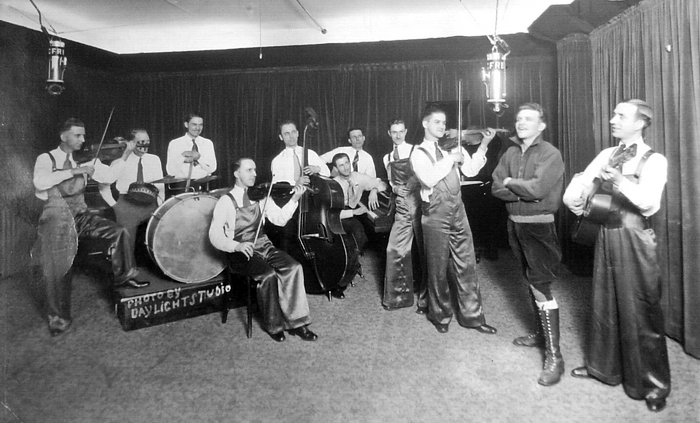
|
|
Undated photograph, presented by Paul Russell, of George Wade and his Cornhuskers in the CFRB studio, circa 1930-31, the photo that launched this project.
Wade has ten musicians, many decked out in rural finery (purple satin overalls?), and George is dressed as a lumberjack.
|
|
|
They re-appeared on Rogers Majestic Corporation's CFRB at the end of the summer of 1929 (G, Aug. 28, 1929, p. 20; G, Sept. 18, 1929, p. 21), on the Viceroy Hour sponsored by the I.T.S. Rubber
Company (G, Oct. 2, 1929, pp. 20 & 21) and were part of the entertainment on The Globe's coverage of the Ontario provincial election, broadcast over CFRB (G, Oct. 30, 1929, p. 1).
From early January, 1930 (TDS, Jan. 18, 1930, p. 16), George Wade and his Cornhuskers appeared in a shindig during the Viceroy Hour on CFRB almost weekly at 11:15 p.m., following The Globe
news (G, Jan. 22, 1930, p. 21). They were part of the Poppy Fund radio song auction at CFRB, accompanying singer/pianist Alice Blue (G, Jan. 27. 1930, p. 13), and later they would "be getting ready
for spring cleaning as they will be fully equipped with Brandram-Henderson decorating materials" (G, March 19, 1930, p. 18). Other sponsors were the Kennedy Hairdressing Parlors and the Rusco Brake
Lining Company. It isn't clear, but the Cornhuskers may have performed their music around little skits as they "again journey to Mudlark Centre to-night at 7:15 over CFRB to be present at the barn raising
of Si Simpkins, a very popular farmer of this community....to enliven the proceedings..." (TDS, Apr. 19, 1930, p. 28). "One of the most popular musical aggregations in the country" entertained for the
Brotherhood of Railroad Trainmen dance at Columbus Hall (TDS, Apr. 30, 1930, p.11), was part of "The Merrymakers" show at Sunnyside Beach in August (G, Aug. 2, 1930, p. 2; Aug. 16, 1930, p. 9)
and part of the "Great Galaxy of 100 Radio Stars" broadcasting over CKNC from the formal opening of Yolles Furniture Store, 379 Queen Street West (TDS, Sept. 27, 1930, p. 18).
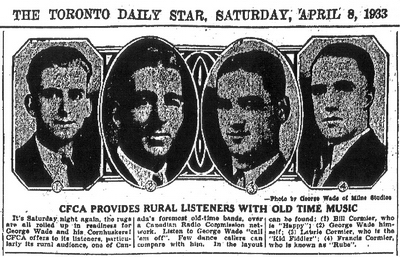
|
|
From left: Bill "Happy" Cormier, George Wade, Laurie
"Kid Fiddler" Cormier and Francis “Rube” Cormier (the photos were by George Wade of Milne Studio), heading a long article on the
coast-to-coast hookup and the thousands listening-in every
Saturday night.
(TDS, Apr. 8, 1933, p. 22)
|
|
|
Wade and his group moved to a weekly program on CKGW, the Gooderham and Worts "Cheerio" station, out of studios in the King Edward Hotel, as of 11:00 p.m. Saturday, October 4 (TDS, Oct. 3, 1930, p. 26).
The Cornhuskers played several nights at the Dewitt Theater in Syracuse in December (SJ, Dec. 9, 1930, p. 12) and then "your favourite radio novelty" appeared in person in a spate of day-only intermission
features in the Toronto Neighbourhood Theatres chain: at the Alhambra on Bloor Street West (TDS, Feb. 7, 1931, p. 8; Mar. 5, 1931, p. 20), at the Palace on Danforth and Pape (TDS, Feb. 25, 1931, p. 13),
the College, the Capitol and the Beach. Wade called for a gala square dance at the Royal York Hotel (TDS, Feb. 27, 1931, p. 1), they donated their services in the Progress Club's "Radio Night" for the Milk Fund
at a packed Massey Hall (TDS, Nov. 5, 1931, p. 31), were among a dozen orchestras at the Warriors' Ball at the Royal York (TDS, Apr. 28, 1932, pp. 30 & 42), were on the new, outdoor mammoth dance floor
at Sunnyside Beach in June (TDS, June 9, 1932, p. 4) and participated in the Milk Fund Show at the new Maple Leaf Gardens (TDS, Nov. 17, 1932, p. 28). Performances in association with local charities seems
to have become a pattern for the Cornhuskers.
In March they were carried over a new network from CKGW to Ottawa and Montreal (Tely, Mar. 2, 1932). When the Canadian Radio Broadcasting Commission (CRBC) came into existence in early 1933,
private Toronto stations, CFCA (Toronto Star station), CKGW, CFRB and CKNC (National Carbon Co.) carried the occasional CRBC programs until the Commission acquired its own outlets. Wade and company
were on the first "outstanding" CRBC program, out of the newly leased-out CKGW (re-named CRCT) and hooked into a trans-Canada network, which was picked up in Toronto only by CFCA: "His music was
fast and filled with rhythms" and "sent rural Canada into rollicking happiness with their old-time dance music.....Thank you Mr. Charlesworth for a program with a little pep in it" (TDS, Feb. 27, 1933, p. 20).

|
|
Undated photograph of George Wade and his Cornhuskers,
taken at CFRB, probably in the early 1930s.
|
|
|
The Cornhuskers became a regular feature on CRBC Saturday nights at 8:00 p.m., relayed over a coast-to-coast network of 34 stations, with many thousands of rural Canadians listening-in. In the CFRB hook-up,
they were featured at 8:00 p.m., before the Maple Leafs' hockey broadcast. Before his eighth show on the CRBC, Wade estimated that his band knew 800 tunes and that he had 60-70% of rural Canadians with
radios as listeners-in. He said, "We can tell from our mail that people don't just listen to our band. They get up and dance. The Smiths ask the Browns in from across the road and they have a real shindig. All over
the country Saturday night clubs are being formed and they use our band to dance to" (TDS, Mar. 11, 1933, p. 20). After ten shows, the Radio Commission had received 6000 fan letters for Wade (Weir, p. 146).
The Cormiers and Cornhusker Personnel
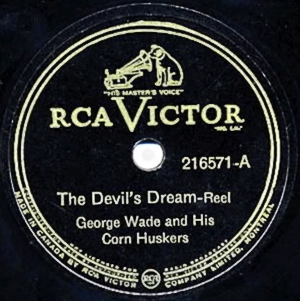
|
|
George Wade and His Corn Huskers, "The Devil's Dream" (Victor 216571-A) was recorded in 1933 and featured a teenage Jean Carignan playing solo fiddle.
|
|
|
Photos of Wade and the Cormier brothers, Bill "Happy", Laurie "Kid Fiddler" and Francis "Rube" Cormier were published in The Star, the photos by George Wade of Milne Studio (TDS, Apr. 8, 1933, p. 22).
The Cormiers were Francophone New Brunswickers, from Memramcook, Westmorland, Dorchester and were difficult to track. Patriarch Edouard D. (1861-1924), a farm worker, and Euphemie had some ten
children: Apolonie/Pauline known as Dolly (born 1888; and married another Cormier), Rosalie, Mary (1892), Elizabeth (1894), Edouard (1896), Guillaume (1898), Eugenie (known as Jennie, born1900),
Frederick (1902), Anthony (1905) and Francis (1909) (Census of Canada, 1911, Cumberland, Nova Scotia). Guillaume and Francis became violinists in the Cornhuskers and the third Cormier fiddler was Laurie,
a son of Apolonie/Dolly Cormier. They went back and forth to Toronto beginning in late 1918, living around Duke Street, First Avenue, Sumach and De Grassi and some worked in market gardens around Ashbridge's
Bay (Russell). In 1921, both Cormier families were living side-by-side on Duke Street (renamed Adelaide Street) in Toronto, where Edouard, Junior, was a shoemaker, owner 1922-25 of Acadian Footwear, slipper
manufacturer on King Street East (M). In the middle 1920s, William "Happy" was employed in the gas works and then at Acadian Footwear, while Francis "Rube" was a carpenter with Dominion Envelope and Laurie
"Kid Fiddler" was a helper and a teamster (M). Paul Russell's Aunt Laura recalled that shoemaker Edouard, Junior, sang briefly with the Cornhuskers (Russell). Except for Laurie in 1930, the Cormier musicians
disappeared from Might's City Directory around 1928. We have no idea how Wade found the Cormiers but they must have been performing in country groups around Toronto.
In April of 1933, the Cornhuskers consisted of Bill Cormier, Francis Cormier, Fred Ford, Frank Perri, Earl Busby, Norman Minns, "Doc" A. Boyd, Pete McGinn, John Burt and Laurie Cormier, featuring three fiddles,
a bass fiddle, a Spanish guitar, a banjo, a Jew's harp, piano, trumpet and drums (TDS, April 8, 1933, p. 22).
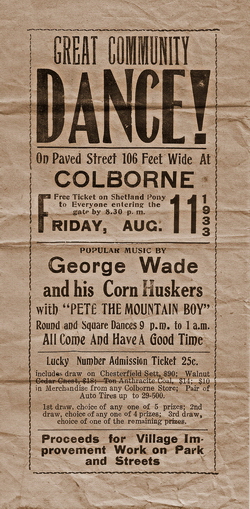
|
|
Flyer for the Great Community street dance in Colborne, Ontario, August 11, 1933, featuring Wade and his Cornhuskers from 9 p.m. to 1 a.m.. For 25c admission,
one had a chance to win a chesterfield set, a walnut cedar chest, a ton of anthracite coal, a $10 gift certificate to any Colborne store or a pair of auto tires.
(Courtesy Betty Minaker Pratt)
|
|
|
The CE lists the personnel, at no particular time, as fiddlers Bill, Francis and Laury (sic.) Cormier, Jean Carignan, Bill Martin, Ted Steven and Johnny Bentley, pianist Johnny Burt, banjoist "Doc" Boyd, Tony Mont
on guitar and Cecil McEachern, bass. Otherwise, Jean Carignan never gets a mention in 1930s listings of the Cornhuskers personnel. The story is that, in 1931, Wade discovered the young Jean Carignan, a
shoemaker's apprentice, playing his violin on a Montreal street during his lunch hour and took him into the orchestra, where he stayed for some six or seven years. Carignan, also known as "the Kid Fiddler"
(G, Feb. 19, 1988, p. D18), soloed in Wade's 1931 recording of "The Devil's Dream" (RCA 216571-A) and said that he also played the saxophone and clarinet for the Cornhuskers (CE). Carignan recalled that
Wade started him at $36 a week, including expenses and, by 1938 he was getting $60. Also that George had eleven musicians, including six fiddlers and that they toured in two big autos with a trailer for the
instruments (Mills).
Touring
The Cornhuskers appeared on March 21 at the Willys' Motor Show in Oshawa (CS, Mar. 16, 1933, p. 30), in May at the Hanlan's Point Roof Gardens, Toronto Islands (TDS, May 29, 1933, p. 6) and at the
Colborne Street Festival on August 11, featuring "Pete the Mountain Boy" McGinn. Later in August in Bowmanville, with the band in purple overalls, Pete captivated the crowd with his yodelling and George and
Pete entertained with jokes between numbers (CS, Aug. 24, 1933, p. 1). The boys were again in costume at the miniature CFRB studio at the C.N.E. (G, Sept. 1, 1933, p. 20).
There was some sort of an eastern tour in the fall of 1933 but documentation is spotty (CG, Oct. 24, 1934). They played the Kiwanis Hallowe'en Dance at the Ottawa Exhibition Grounds, when over 1500
people turned out in aid of the Kiwanis Boys' Club (OC, Nov 1, 1933, p. 15). A week later, Wade was part of "Celebration of Canadian Radio" from CRCT, Toronto (OC, Nov. 10, 1933, p. 14). We found
Wade at the Masonic Temple in Sherbrooke that December, in two benefits for the Tuberculosis Veterans Section, Quebec (ST, Dec. 14, 1933, p. 10), but the rest of the tour is a puzzle. Local promotions
for "Cornhuskers" dances appear in the SJET-G as early as November 12, 1932 (p. 2), through 1933 (SJET-G, Jan. 6, p. 2; Apr. 13, p. 2; June 7, p. 2; Oct. 21, p,.2; Dec. 12, p. 2) and into February 1934
(SJET-G, Feb. 26, 1934, p. 2), but they give Don Messer as leader of the Cornhuskers and The Cornhuskers Orchestra at the Crescent Gardens, Saint John. No Messer biographies mention "Messer's Cornhuskers",
so perhaps this was a name appropriation and accounts for reported coolness from Wade. The story of Messer being called on stage at Saint John to help Wade with a tune "around 1933" (Bertin, p. 63) is not
supported by any documentation. Wade's group must have been away from Toronto for a time, however, because an advertisement for a dance at Columbus Hall, Toronto, January 15, 1934, was headed
"Welcome Home...First Toronto Appearance" (TDS, Jan. 12, 1934, p. 9). Fans, concerned that Wade had disappeared, wrote to CFRB and were assured that he would be back on the air the next day (G, Jan. 16, 1934, p. 9).

|
|
Advertisement for a dance in St. Stephen, N.B. during the 1934 tour, St. Croix Courier, October 16, 1934.
(Courtesy Rob Gilmore)
|
|
|
In April 1934, his old CFRB boss Ernie Bushnell recruited Wade for a new Saturday night series on the CRBC, to begin on the 21st (TDS, Apr. 10, 1934, p. 37) and they became one of the most popular programs
on CRCT, CKNC and CKCL (Stursberg, p. 47). The last listing was for July 27 (TDS, July 27, 1934, p. 22). They took off on a barnstorming tour in the countryside (TDS, Sept. 22, 1934, p. 22) and the newspaper
record shows that George Wade and his Cornhuskers broadcast only one more series after that tour, in 1940.
On this Maritimes tour, in which wife Alice accompanied Wade, the "King of the Barn Dance" appeared in Granby on September 27 (GLM, Sept. 21, 1934, p. 5; ibid. Oct. 5, 1934, p. 4), was broadcast over CFCF,
Montreal a week later, in October at the Casa Loma in St. Croix, N.B. (SCC, Sept. 27, 1934, p. 2), playing old-time and modern dance music with a floor show featuring "Red" Hughes, the Red River Valley Cowboy
and "Jim the Hired Man". Wanting to appeal to the widest audience, Wade included novelty features and vaudeville and had his nine men doubling and tripling on big-band instruments like clarinet, sax and trumpet
for the modern dances (fox trots and waltzes - one of the Cormiers played clarinet). Advertised as "The Original"(FDG, Oct. 24, 1934), it would appear, however, that he had hired a mostly new crew and guest
artists for the 1934 tour, including fiddler and arranger Jim Magill, fiddler Bill Martin directing the square dances and William Hahndorn for the modern dances (MDT, Oct. 9, 1934; FDG, Oct. 26, 1934). October 5
at the Pythian Castle, Saint John (SJET-G, Oct. 4, 1934, p. 15), the Stadium in Moncton where 1,800 attended, auspices of the Moncton Free School Dental Clinic (MDT, Oct. 6 & 9, 1934), two engagements in
St. Stephen for Kiwanis (SCC, Oct. 11 & 16, 1934) and then at Nelson Hall in Halifax (HH, Oct. 11, 1934, p. 14). He told the Halifax Herald that "people are becoming tired of the hot jazz stuff and are turning to
smoother melodies.....The hot bands are dying out or are dead; the dancers of today are going in for the sweet, soft stuff. This can be attributed to the fact that dance bands playing the ‘hot music' did not know
much about music; consequently the harmony and melody did not co-ordinate" (HH, Oct. 11, 1934, p. 2).
On the other hand, the late Graham Townsend told Steve Fruitman of CIUT Radio in 1997 that the thing about Wade's music was the simplicity of the scoring - probably by Johnny Burt. Townsend said, "You can
add 8 or 10 or 12 chords instead of 3 or 4, but then you're getting above what the music really is - old-time music is the music of the people and they like it kept simple" (Townsend).
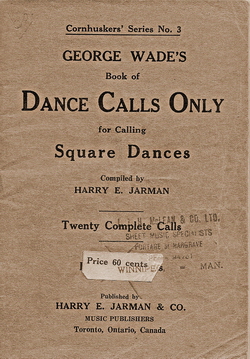
|
|
Wade’s calls, steps and tunes were published in a series of booklets compiled by Wade and Jarman in the 1930s.
(Courtesy Betty Minaker Pratt)
|
|
|
In Shediac, George was re-united with his oldest brother Joseph, calling himself Joseph Wedge of Shediac, whom he had not seen in 31 years, since young George and his mother had left Summerside for Souris
around 1903 (MDT, Oct. 13, 1934).
Then to The Armouries in Amherst, where the Red River Cowboy enchanted with his yodelling and some 500 dancers were on the floor (ADN, Oct. 18, 1934). To the Prince of Wales College Hall in Charlottetown
on the 24th where the capacity audience joined in on the choruses (CEP, Oct. 24 & 25, 1934), jammed Oddfellows Hall, Fredericton, on the 25th (FDG, Oct. 24 & 26, 1934) and gave its New Brunswick farewell
at the Chateau St. Jean near Woodstock on the 27th (FDG, Oct. 26, 1934). They were scheduled to re-appear in Granby on the way back on November 2 (GLM, Oct. 5, 1934, p. 4).
The personnel listed in the Fredericton Daily Gleaner (Oct. 26, 1934) were very different from the old Cornhuskers group and from known lists of the Cornhuskers: Carl Read, A. Adams, G. Mills, W. Hohendorf,
R. Tait, W. Martin, G. Stevens, H. Hughes (the Red River Cowboy) and J. Magill, Toronto. Only in and after the Charlottetown dance was Wade noted as leading the group in person.
Wade and Harry Jarman of CKGW published booklets of his calls. "The Cornhuskers' Book of Square Dances" and one of scores, "Musical Accompaniment for Square Dances", and they won charges against Alf
Hannigan for infringement of copyright on his calls (TDS, Jan. 10, 1933, p. 2). Hannigan was fined $10 and $10 for each illegal copy sold.
We found Wade playing the Willow Beach Pavilion, Wilcox Lake, Ontario, in August 1935 (TDS, Aug. 19, 1935, p. 21) and then he was off on his western tour, playing Copper Cliff in August (Inco), and curiously
promoted at the Trianon in Regina as "Wade and his 12 Montreal Kings, Canadian Radio Commission Artists" on September 4 (RLP, Sept. 4, 1935, p. 2). Before Regina, they were Wade and his Cornhuskers
at the River Park Roller Rink, Winnipeg, on August 28th (WFP, Aug 24, 1935, p. 11). They swung back from their triumphal tour to appear in a post-gala dance at Winnipeg Auditorium, the promotion saying:
"George...calls off reels and square dances in a way that starts even those in the sidelines jigging and toe-tapping..." (WFP, Sept. 21, 1935, p. 8). But fashions were changing and George had to appeal for
square dancers because the audience wanted modern dances (WFP, Sept. 23, 1935, p. 1).
References:
1906 Canadian Census of Manitoba, Saskatchewan and Alberta
1916 Manitoba Census
1861,1871, 1881, 1891, 1901, 1911 and 1921 Census of Canada
ADN - Amherst Daily News, Amherst, Nova Scotia
Ancestry.ca on-line website
BE - Barrie Examiner, Barrie, Ontario
Bertin - "Don Messer: The Man Behind the Music" by Johanna Bertin (Goose Lane Editions, Fredericton, N.B., 2009)
Canadian Kennel Club Stud Book, Volume 48, December 31, 1944, etc.
CEA-VL - Canada Elections Act - Voters List
CE - Canadian Encyclopedia on-line, Historica Dominion
CEP - Charlottetown Evening-Patriot, Charlottetown, P.E.I.
CG - Charlottetown Guardian, Charlottetown, P.E.I.
CS - The Canadian Statesman, Bowmanville, Ontario
CTAR - City of Toronto Assessment Rolls, City of Toronto Archives
Dominion Elections List, found on-line by Rob Gilmore, New Brunswick Archives
FDG - Fredericton Daily Gleaner, Fredericton, New Brunswick
G - The Globe, Toronto and The Globe and Mail, Toronto, Ontario
GLM - Granby Leader-Mail, Granby, Quebec
HH - Halifax Herald, Halifax, Nova Scotia
Inco - Inco Triangle, vol. 6 #4, July 1946, p. 11
International Musician, Official Journal of the American Federation of Musicians, Syracuse, New York, U.S.A.
Isenor - personal communication from Fred Isenor, CAPS member from Nova Scotia, Jan. 2014.
LAC - Library and Archives Canada, RG 150, Accession 1992-93/166, Box 9984-47), Order ID-13098
Litchfield - "The Canadian Victor 216000 Series: Estimating the Recording Dates" by Jack Litchfield (self-published, 2012)
Lovell's Montreal City Directories
M - Might's City of Toronto Directories
MCC - The Milton Canadian Champion, Milton, Ontario
MDS - Montreal Daily Star, Montreal, Quebec
MDT - Moncton Daily Times, Moncton, New Brunswick
Mills - Note by Alan Mills in "Old Time Fiddle Tunes Played by Jean Carignan" Folkways Records FG 3531
NEE - Newmarket Era and Express, Newmarket, Ontario
OC - Ottawa Citizen, Ottawa, Ontario
Owen - "Divorce in a Small Province: A History of Divorce in Prince Edward Island from 1833" by Wendy Owen and J.M. Bumstead; Acadiensis, vol 20 #2, Spring 1991, pp. 86-104.
PE - Peterborough Examiner, Peterborough, Ontario
RD St. John - Registration Division of St. John city and County: "Deaths" No. 003727
Russell - Paul G. Russell, Toronto, personal communications, 2012 and June 21, 2103
RLP - Regina Leader Post, Regina, Saskatchewan
"The Story of CFRB: Sinc, Betty and the Morning Man" by Donald Mack (Macmillan of Canada, Toronto, 1977)
SACR - Swansea Assessment and Collectors Rolls, 1930, page 77 (City of Toronto Archives).
SCC - St. Croix Courier, St. Croix, New Brunswick
SJ - The Syracuse Journal, Syracuse, New York
SJET-G - Saint John Evening Times-Globe, Saint John, New Brunswick
SS - Sunday Sun newspaper, Toronto, Ontario
ST - Sherbrooke Telegram, Sherbrooke, Quebec
Steve Fruitman, Radio CIUT, Toronto, personal communication, August 19, 2013
Stursberg - "Mister Broadcasting: The Ernie Bushnell Story" by Peter Stursberg (Peter Martin Associates Limited, Toronto, 1971; pp. 21 & 47)
TDS - Toronto Daily Star, Toronto, Ontario
Tely -The Toronto Telegram, Toronto, Ontario
Townsend - Graham Townsend interview on "The Great North Wind" over CIUT, University of Toronto Radio, Toronto, Sept. 29, 1997, hosted by Steve Fruitman.
Weir - "The Struggle for National Broadcasting in Canada" by E. Austin Weir (McClelland and Stewart, Toronto, 1965)
WFP - Winnipeg Free Press, Winnipeg, Manitoba
WJW - William J. Wade, Riverview, New Brunswick, personal communication, May 27, June 8 and 12, 2014
Special thanks for invaluable research to Rob Gilmore, Public Service Archivist of the Provincial Archives of New Brunswick, who joined the team and found the Wait/Wade and Cormier genealogies for us,
documented Wade's Maritime tours and opened up many other aspects of the study. Thanks to Paul G. Russell of Toronto; to William J. Wade of Riverview, New Brunswick; to David Lennick, Jack Litchfield, Bill Pratt and Fred Isenor
of CAPS; to Richard Green of the National Library and Archives in Ottawa; to Lee Ramsay and colleagues at Toronto Reference Library; to the Holy Cross Church and Cemetery, Toronto; to Heather
Alten Landry of the Trent Valley Archives; to the Archives of Ontario; to Toronto City Archives; to Public Archives of Prince Edward Island; to the Legislative Library, Winnipeg; to Souris Town Archive and to Kathy Jacques of Whitby.
Thanks also to Vincent Cormier and Eddie Poirier of the "Bluegrass Diamonds" of Memramcook, N.B. and to Cate McCoy who put us onto the most helpful Steve Fruitman and his 33.45.78 -
The CIUT 89.5 FM All Vinyl Radio Show of University of Toronto Radio,
CIUT.
|